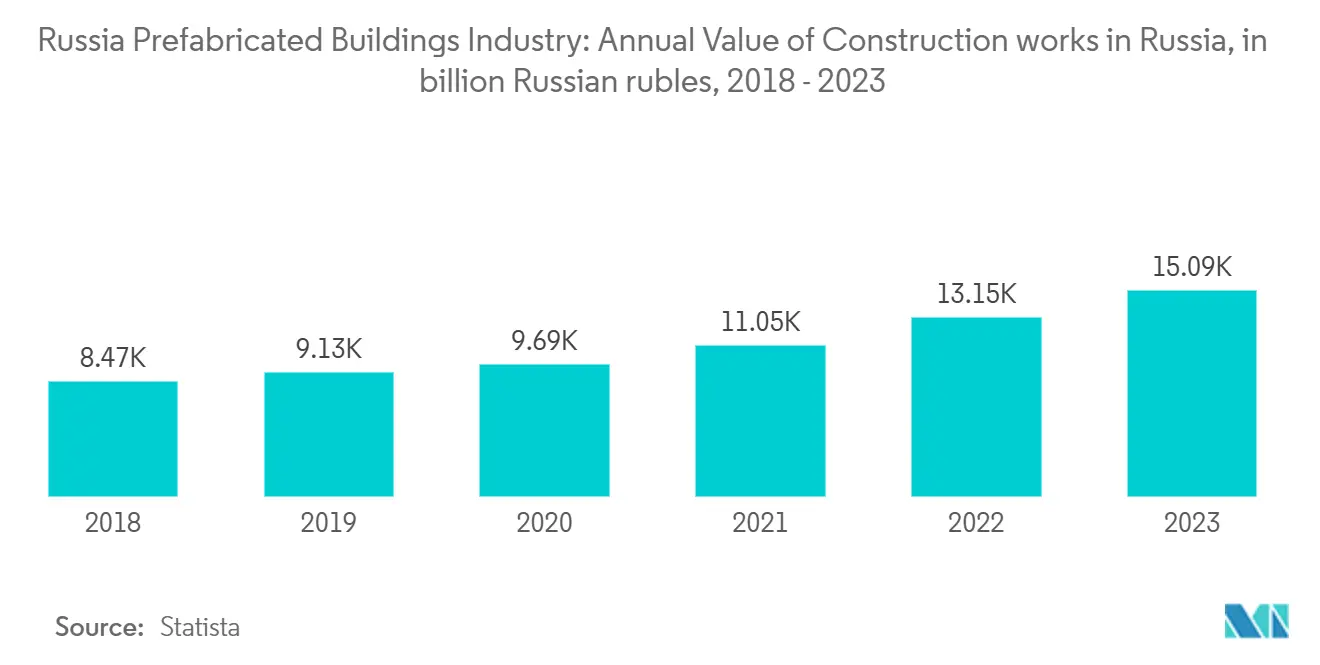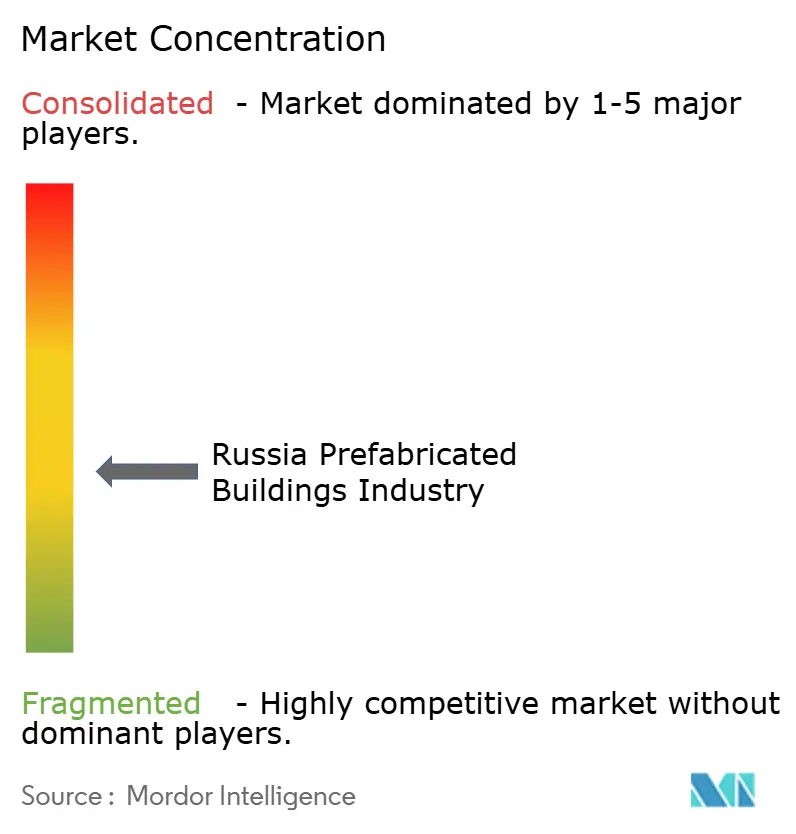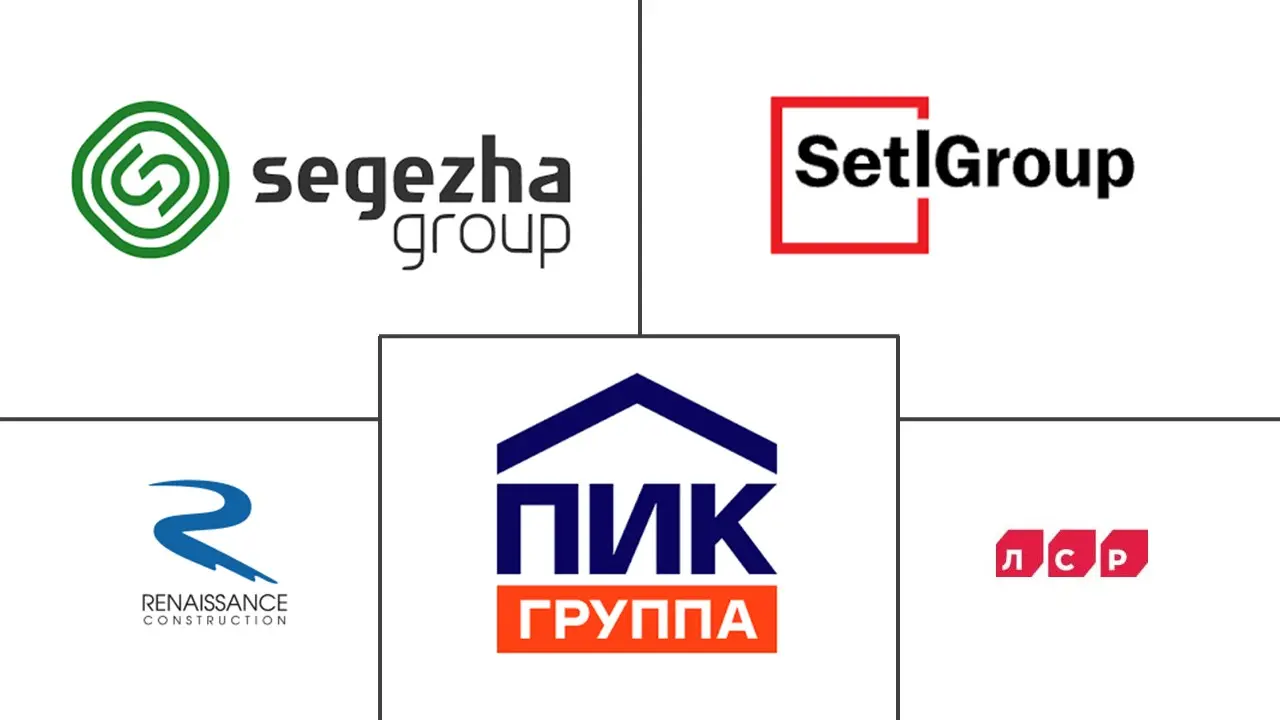
Russia Prefabricated Buildings Industry Analysis by Mordor Intelligence
The Russia Prefabricated Buildings Industry is expected to register a CAGR of greater than 5% during the forecast period.
Driven by a surge in demand for efficient and cost-effective construction solutions, Russia's prefabricated buildings market is on the rise. Prefabricated buildings, known for their quicker construction times, enhanced quality control, and cost savings over traditional methods, are becoming the go-to choice across various sectors in Russia. These sectors span residential, commercial, industrial, and infrastructure projects.
Urbanization in Russia, coupled with government pushes for affordable housing, is spurring a significant demand for new residential buildings. This demand is further amplified by the urgent need for commercial, industrial, and infrastructure projects. Technological innovations like Building Information Modeling (BIM) and 3D printing are enhancing the efficiency and quality of prefabricated constructions.
However, the ongoing conflict between Russia and Ukraine, alongside U.S. and international sanctions, has thrown a wrench into market operations. These sanctions have notably disrupted supply chains and driven up raw material costs. Yet, as the trend shifts towards turnkey housing solutions, the prefabricated housing market in Russia is poised for growth. Simplified preparation and consent procedures further bolster this demand.
Russia boasts several companies that specialize in Cross-Laminated Timber (CLT) production and home construction. While CLT is a nascent product in Russia, Western European nations have long embraced it, constructing residential and commercial buildings soaring up to 14 stories. Recent announcements of new Russian standards for wooden building construction, permitting multi-story structures with laminated wood framing, are propelling the wood prefabricated buildings market.
Russia Prefabricated Buildings Industry Trends and Insights
Russian Government Boosts Initiatives to Propel Construction Industry
In Russia, government initiatives are fueling a surge in the prefabricated buildings market. The Russian government is pouring investments into infrastructure, housing, and modernizing construction practices. Prefabrication, known for its cost-effectiveness and speed, dovetails perfectly with Russia's urban development ambitions. Initiatives like the "Housing and Urban Environment" project, which seeks to uplift living standards and ramp up housing construction, have spurred a robust demand for prefabricated structures.
As highlighted by the Deputy Prime Minister, Russia's construction sector has witnessed unprecedented growth. The "Housing and Urban Environment" initiative is in full swing. Just last year, the country saw the completion of 110.4 million square meters of housing, benefiting 4.4 million families. Furthermore, government incentives and regulatory changes have paved the way for modular construction's rise. Policies championing energy efficiency and sustainability have bolstered the prefabricated buildings market. With tax breaks and subsidies backing industrialized construction methods, developers are increasingly turning to prefabrication technology. This shift not only accelerates construction timelines but also addresses the labor shortages plaguing Russia's construction industry.
Public-private partnerships (PPPs) in major infrastructure endeavors, spanning hospitals to commercial hubs, have heightened the appetite for prefabricated buildings. The government's drive to rejuvenate aging Soviet-era structures and broaden social infrastructure has funneled more investments into modular construction. Given its rapid deployment and superior quality control, prefabrication is emerging as a pivotal solution to satiate the growing demand for both residential and commercial properties. These dynamics are poised to propel the market's growth in the coming years.

Increasing Costs of Traditional Building Construction over Prefab is Driving the Market
In Russia, the prefabricated buildings market is witnessing robust growth, largely fueled by technological advancements in the construction sector. Innovations like Building Information Modeling (BIM), automation, and 3D printing are boosting the efficiency, precision, and cost-effectiveness of modular construction. With BIM, developers can design and simulate prefabricated structures with pinpoint accuracy, minimizing errors and optimizing material use.
Manufacturing processes are being revolutionized through automation, featuring robotic assembly lines and AI-driven quality control. This not only accelerates production but also ensures a consistent quality in buildings. Such advancements lead to significant reductions in construction time and labor costs, positioning prefabricated buildings as a prime choice for Russia's burgeoning urban and industrial infrastructure.
The market's growth is further propelled by the adoption of cutting-edge materials like Cross-Laminated Timber (CLT) and high-performance concrete. CLT, rapidly gaining traction in Russia, stands out as a sustainable and durable substitute for conventional materials, effectively curbing construction waste and carbon emissions.
Moreover, 3D printing technology is being harnessed for swift on-site assembly of prefabricated components, offering enhanced design flexibility and cost efficiencies. These technological strides resonate with Russia's ambition to modernize its construction landscape, leading to a heightened embrace of prefabricated buildings across residential, commercial, and public infrastructure projects. With the relentless march of technological evolution, Russia's prefabricated buildings market is poised for further expansion, promising innovative and sustainable solutions to address the nation's escalating construction needs.

Competitive Landscape
The report covers the major players operating in the Russian prefabricated buildings market. The market is highly competitive with a few players occupying the major share. Companies are focusing on technological innovations. Some suppliers are providing fully customized, prefabricated wooden structures. High capital requirements and rapid technological advancement are few barriers to entry for new participants. Intensified competition led to the emergence of many innovative and advanced solutions in the market, such as turnkey solutions and lightweight ceramic houses.
Therefore, achieving sustainability, expanding to other regions, and restoring domestic demand are important factors for companies. Companies can implement effective production technologies to minimize product costs and reduce related risks, thereby increasing profitability. Segezha Group, PIK Group of Companies, LSR group, St. Petersburg, and Renaissance Construction are the few major players in Russia's prefabricated buildings market.
Russia Prefabricated Buildings Market Leaders
-
PIK Group of Companies
-
LSR group. St. Petersburg
-
Segezha Group
-
Renaissance Construction
-
Setl group. St. Petersburg
- *Disclaimer: Major Players sorted in no particular order

Recent Industry Developments
- October 2024: BI Group, one of Kazakhstan’s largest real estate developers, making its U.S. debut with a new residential project in Miami’s financial district. The development features luxury apartments with potential returns of 10% and starting prices of USD 477,000, as well as villas priced from USD 6.8 million.
- December 2024: Etalon Group PLC, one of Russia’s largest development and construction companies, announced that they received a construction permit and begun sales at its MariInn Park residential complex in Moscow.
Russia Prefabricated Buildings Industry Report Scope
Prefabricated buildings (also known as prefabs) are building structures manufactured offsite and transported to the on-site assembly location. It is made up of parts or units that are made in a factory and then shipped to the building site to be put together.
Russia's Prefabricated Buildings Market is segmented by Material Type (Concrete, Glass, Metal, Timber, and Other Material Types) and Application (Residential, Commercial, and Other Applications (Industrial, Institutional, and Infrastructure)). The report offers market size and forecast in value (USD billion) for all the above segments.
| Concrete |
| Glass |
| Metal |
| Timber |
| Other Material Types |
| Residential |
| Commercial |
| Other Applications (Industrial, Institutional, and Infrastructure) |
| By Material Type | Concrete |
| Glass | |
| Metal | |
| Timber | |
| Other Material Types | |
| By Application | Residential |
| Commercial | |
| Other Applications (Industrial, Institutional, and Infrastructure) |
Key Questions Answered in the Report
What is the current Russia Prefabricated Buildings Industry size?
The Russia Prefabricated Buildings Industry is projected to register a CAGR of greater than 5% during the forecast period (2025-2030)
Who are the key players in Russia Prefabricated Buildings Industry?
PIK Group of Companies, LSR group. St. Petersburg, Segezha Group, Renaissance Construction and Setl group. St. Petersburg are the major companies operating in the Russia Prefabricated Buildings Industry.
What years does this Russia Prefabricated Buildings Industry cover?
The report covers the Russia Prefabricated Buildings Industry historical market size for years: 2019, 2020, 2021, 2022, 2023 and 2024. The report also forecasts the Russia Prefabricated Buildings Industry size for years: 2025, 2026, 2027, 2028, 2029 and 2030.
Page last updated on:
Russia Prefabricated Buildings Industry Report
Statistics for the 2025 Russia Prefabricated Buildings Industry market share, size and revenue growth rate, created by Mordor Intelligence™ Industry Reports. Russia Prefabricated Buildings Industry analysis includes a market forecast outlook for 2025 to 2030 and historical overview. Get a sample of this industry analysis as a free report PDF download.



